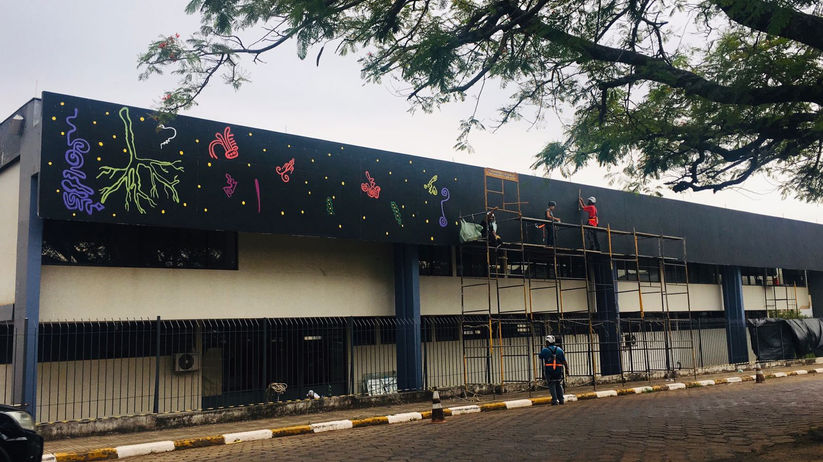painting of the work
"constellations"
BY DENILSON BANIWA
on the facades of the tatuí conservatory
From now on, everyone who comes to the Conservatory of Tatuí will be welcomed and enchanted by the work "Constellations", by Denilson Baniwa, painted on the facades of the building.
The project was made by Outra Margem, invited by the Conservatory of Tatuí; as well as by the partnership with artist Dinas Miguel and team, responsible for the execution of the painting.
ABOUT THE CONSERVATORY
The Drama and Music Conservatory "Dr. Carlos de Campos" de Tatuí - or simply Conservatory of Tatuí, as it is known internationally - represents one of the most serious and successful actions in the cultural sector in the state of São Paulo. With over 60 years of training and cultural dissemination, one of the most respected music schools in Latin America fulfills the mission of training instrumentalists, singers, actors, and luthiers of international prestige. Its more than 50 different regular courses, all free of charge, last an average of seven years, and its students always stand out in national and international competitions.
The institution is located 130 km from São Paulo City, and receives students from all over Brazil and also from several countries abroad. Many foreigners look to the Tautí Conservatory to improve their knowledge of Brazilian music.
ABOUT THE WORK (TEXT BY DENILSON BANIWA)
"Constellations" alludes to the teachings of the Elders, who tell us that there were extraordinary beings in the Cosmos. In constant transformation, they lived together on this planet and could change their form according to what they wanted. A hummingbird might change into a macaw, then into a frog, then into a fish, or perhaps into a rock or a tree. These beings were responsible for the balance and reproduction of life on Earth.
Our ecosystem encompasses a multitude of these Beings. They are now invisible; however, they still make it possible to maintain life in the Amazon. They help in pollination, in caring for the environment, and in sharing experiences. Only shamans can see these beings. However, even without seeing them, normal people like us can benefit from their work.
Western science has been important in ensuring that the ecosystem remains protected. The invisible beings of the forest also benefit, for they need the forest to live. During these contacts with other worlds, traveling artists and naturalists have been in the Americas, documenting much of its biodiversity, studying insects, plants, and recording details of each of these living things through art. One such artist, perhaps the only woman among many male artists, was the important naturalist and scientific illustrator Maria Sibylla Merian from Frankfurt. Merian's works depict the metamorphosis of animals, following various life stages of insects, arachnids, and others in a direct relationship with plants, rocks, and soil. His work is very important for us to think about the relationships of exchange and change that make the continuity of life possible. Unlike most artists of her time, she was concerned with documenting life in transformation, in the changing stages of beings.
In contrast to Maria Sibylla Merian, my work intends to give a glimpse of a different relationship with life, understanding the visible and the invisible. In Baniwa cosmology, beings that transform and change form are important for the continuity of life on earth. At the same time, we can think about this in relation to science and indigenous cultures, the colonization of the Americas, and how the lives of indigenous people have endured throughout history. The contrast between these Baniwa beings and Merian's tangible beings makes us think about the diversity of knowledge that we ignore or do not yet know. Bringing the Baniwa cosmology to the mural, is so that these beings can appear and fulfill their purpose of pollinating memories and transforming forests, means sharing a bit of indigenous worlds and their cosmology.
ABOUT THE ARTISTS
Denilson Baniwa was born in Mariuá, Rio Negro, Amazonas. He is a visual artist and communicator who carries out his artistic processes based on the Amazonian Indigenous Movement and through transit in the non-Indigenous universe. Baniwa, in his contemporary trajectory, consolidates himself as a reference, breaking paradigms and opening paths to the protagonism of indigenous people in the national territory.
Dinas Miguel is creator and organizer of the social project "Culture and Concept" and winner of the Sabotage Hip-Hop Award in the category of best graffiti artist of 2018. He conducts collective graffiti workshops, live painting in events, acts as an art educator in several projects and is an activist of the indigenous cause, having already done several works with indigenous peoples.
CREDITS
PRODUCTION
Outra Margem and Tatuí Conservatory
DIRECTION
Andreia Duarte
Antonio Salvador
AUTHOR
Denilson Baniwa
PAINTING
Dinas Miguel
PAINTING ASSISTANTS
Kaio Magalhães
Thiago Coqueiro
Ciel
PRODUCTION
Michelle Barreto
CONTENTS
Luna Rosa Recaldes
FINANCIAL ADMINISTRATION
Arami Argüello
CONSERVATORY OF TATUÍ - UNIT 2
Rua São Bento, 808 - Centro, Tatuí - SP, 18270-820
NOVEMBER/DECEMBER 2022












